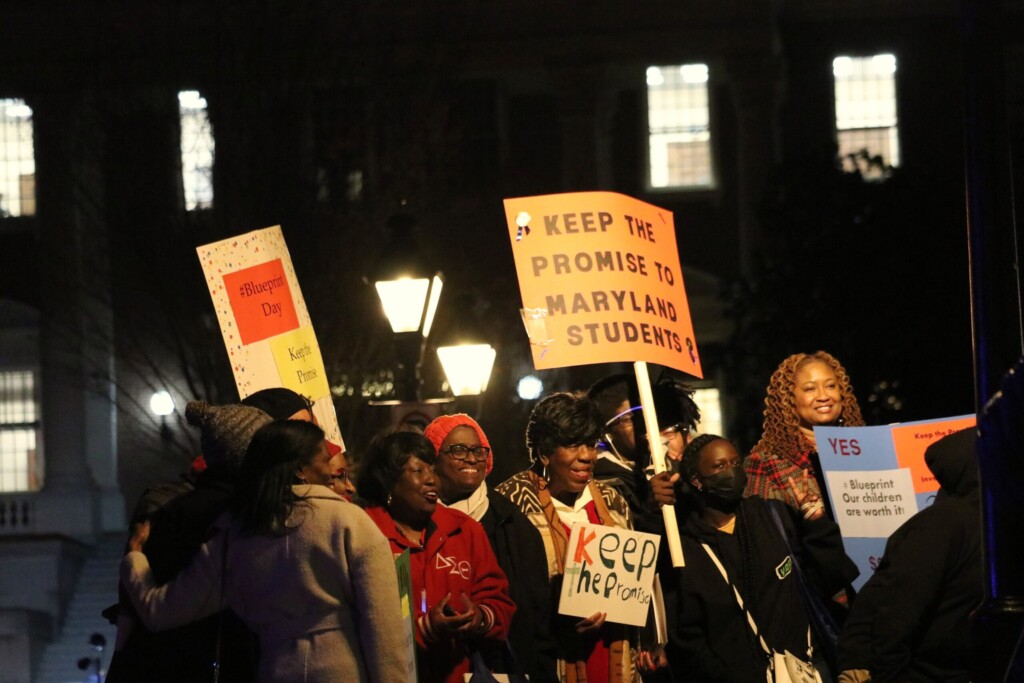This article was republished with permission from WTOP’s news partners at Maryland Matters. Sign up for Maryland Matters’ free email subscription today.
This content was republished with permission from WTOP’s news partners at Maryland Matters. Sign up for Maryland Matters’ free email subscription today.

Among the many duties Ma’ryah Baynard has as a community activist, curriculum developer and peer mediator, one of her top goals is mental health support at her high school in Baltimore City.
The 18-year-old senior at Baltimore Leadership School for Young Women wants Maryland’s top brass – Gov. Wes Moore (D), House Speaker Adrienne Jones (D-Baltimore County) and Senate President Bill Ferguson (D-Baltimore City) – to support and fund mental health services for her peers as part of the Blueprint for Maryland’s Future education reform plan.
“If we take this into consideration, I believe that a full continuation of this blueprint is beneficial because these different opportunities such as mental health resources will be implemented into many schools so that students will receive a better education in a better environment,” Baynard said Monday outside Lawyers’ Mall in Annapolis.
Baynard joined dozens of other students, parents, educators and advocates to push state lawmakers with this one message: keep the promise to “fully fund the Blueprint.”
The General Assembly passed the Blueprint into law in 2021, less than a year after former Gov. Larry Hogan (R) vetoed the plan because he deemed it too expensive.
Moore released his budget proposal last month, including a one-time cash payment of $500 million – on top of education formula funding – to bolster the Blueprint’s trust fund, the state’s saving account for the plan.

However, more money could be needed because of an increased number of low-income students captured in state data; those students are significant in the funding formula, which directs more money to schools with a higher concentration of poverty.
While the education fund is expected to have a $2.2 billion balance at the end of Moore’s fiscal year 2024 budget, the fund would have a near-zero balance in 2026 and become overextended in 2027, according to projections.
Strong Schools Maryland and the Coalition for the Blueprint for Maryland’s Future, which organized Monday’s rally, summarized three legislative priorities:
- Supporting the implementation for the Blueprint for Maryland’s Future – including expansion of prekindergarten programs to accommodate for 3- and 4-year-old students.
- Building strong, student-oriented community schools by supporting the national Community Schools strategy.
- Creating safe learning environments for all, including investment in restorative practices and shifting away from “punitive discipline, policing and other developmental or ethically inappropriate practices.”
The rally came before a March 15 deadline for local school officials to submit their Blueprint plans through the 2023-24 school year.
Shamoyia Gardiner, executive director of Strong Schools Maryland, praised Moore for allocating the half-billion dollars into next year’s budget. However, she expressed concern about the overall financial forecast for education reform.
“The blueprint may be law, but there’s still work to be done,” Gardiner said. “There are tough economic times ahead of us, as there always seem to be when it comes to funding public schools. But we rally… to let Gov. Moore, President Ferguson, Speaker Jones and all our elected and appointed officials know that we are relying on them to keep the promise.”
AIB staffing
Work on the education plan will continue through the Blueprint for Maryland’s Future Accountability and Implementation Board (AIB), an independent body created to ensure local school officials implement the plan.
On Thursday, the board approved a hiring process and plan to staff the AIB. The people hired would include five education policy analysts and local school systems liaisons, a deputy director, a research/data analyst, an executive assistant, a research and accountability director and an outreach and communications director.
Rachel Hise, the board’s executive director, said the process to hire an assistant attorney general has begun and is being overseen by the state Attorney General’s Office.
According to a summary of the staffing plan, the hiring process for each position could take at least eight weeks.
Board Chair Isiah “Ike” Leggett said certain positions could be filled on a temporary basis or and the board may explore ways to bring in some workers quicker.
“It’s hard to speed the process up. We’re going to move as fast as we can,” said Hise, who added that the state Department of Budget and Management will help review and approve job descriptions.
William “Brit” Kirwan, vice chair of the board and former chancellor of the University System of Maryland, said the outreach and communications director is a “critically important” position.
“There is an amazing story here with the Blueprint,” he said. “For the Blueprint to have buy-in and support, we’ve got to be able to tell the story to the general public.”
The law allows for the accountability board to have up to 15 full-time positions. So far, four employees have been hired: Hise; Rachel Amstutz, operations and policy director; Emma Pellerin, implementation plan director; and Graham Hardig, management associate.
Hise said the board’s work is currently conducted remotely, but the goal will be for both remote and in-person work once more new employees are hired.
People interested in applying for the positions can send resumes and letters of interest via email to aib@maryland.gov.
The AIB hiring process includes a diversity, equity and inclusion statement which states in part: The “AIB is committed to recruiting, retaining and promoting individuals who have historically been underrepresented in policymaking and government, particularly those who represent the diversity of communities that are served by the Blueprint for Maryland’s Future.”
At Thursday’s meeting, Hise virtually introduced Lisa Armstrong, recently hired as a management associate to track bills with a potential impact on the Blueprint plan during this year’s 90-day legislative session. Armstrong’s currently enrolled in the doctoral program at the University of Maryland Baltimore County and works as a speech and language pathologist for Baltimore County Public Schools.
The estimated $4.8 million for the AIB in next year’s fiscal budget will be reviewed Friday during a hearing before the Senate’s Education, Business and Administration Subcommittee.
About $2.1 million would be designated for salaries, wages and fringe benefits and another $296,000 for contractual services.
Another $1.9 million in grants, subsidies and contributions would account for mostly technical assistance, Hise said.







